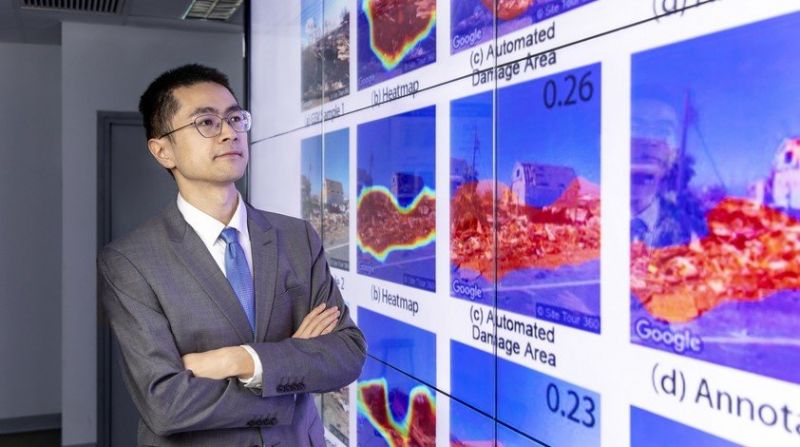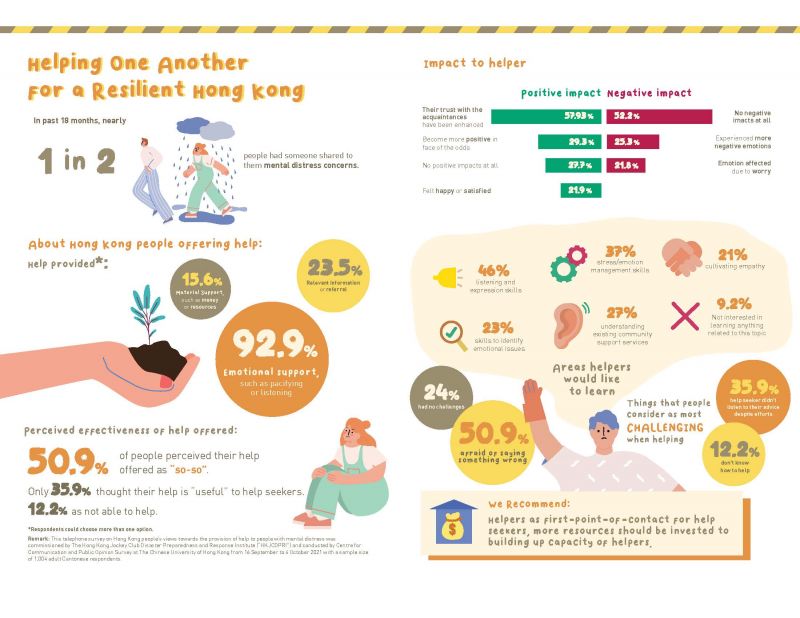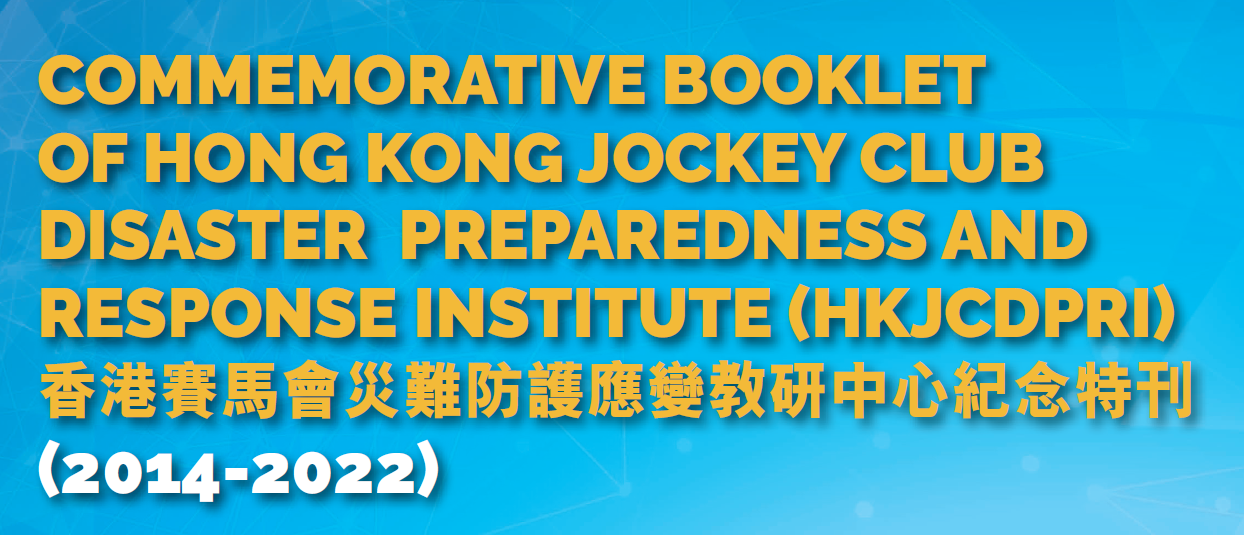You are here
Publications & Research
Publications & Research

Publications & Research
The HKJCDPRI Publications Section contains collaborative researches and publications with our partners and renowned academic institutions, and other research and development projects related to disaster preparedness and response.
The Guidelines section contains our selected collection of technical information, operational guidelines and useful tools for disaster management.
The Blog sub-section provides a platform where our team and peers share news and updates, as well as opinions and experiences in building disaster preparedness for the communities.
The blog posts are written by the author in his own personal capacity / affiliation stated. The views, thoughts and opinions expressed in the post belong solely to the author and does not necessarily represent those of Hong Kong Jockey Club Disaster Preparedness and Response Institute.
All resources listed here are freely and publicly available, unless specified otherwise. We ask users to use them with respect and credit the authors as appropriate.
2022

*This article originates from Hong Kong Baptist University
4 January 2022
Peaking with one-minute sustained winds of 285 km/h, the Category 5 Hurricane Irma ripped through the Caribbean islands and the southeast of the United States in September 2017. After the storm made landfall in Florida, it caused widespread destruction along its path, tearing off roofs, flooding coastal cities, and causing at least 84 fatalities in the state.

Dr Zhai has been researching the use of artificial intelligence to improve our understanding of individuals' perception of disasters and the damage they cause. The research team found that damage assessments based on Google Street View images can provide timely and accurate data on the ground. Such information is invaluable to humanitarian organisations and disaster management practitioners, as it allows them to devise recovery strategies.
The impact of the deadly storm and the local government's response to the disaster made a lasting impression on Dr. Zhai Wai
, who was then pursuing his postgraduate studies at the University of Florida, and he had just arrived in the state a few days before the hurricane hit.
Four years later, he is investigating how to improve disaster management. "Seeing firsthand how disasters such as hurricanes and flooding affect the people living in coastal regions, I believe that urban planners play an important role in helping governments develop strategies to respond to the disasters and improve social equity in the face of extreme weather events," says the Assistant Professor of the Department of Geography.
A human-centric approach
Assessing how people perceive risk and damage in the context of natural hazards is central to improving disaster preparedness and recovery. To that end, Dr Zhai has been researching the use of artificial intelligence (AI) to improve our understanding of individuals’ perception of disasters and the damage they cause.
In a study examining the use of Google Street View (GSV) images in damage assessment, Dr Zhai and his colleagues looked at how the human eye perceives the amount of damage present in GSV images. "Existing approaches, such as remote sensing imagery, typically use satellite imagery and measure the damage in an area at a distance, but this cannot reflect how people are actually interpreting the disaster situation. Our research took a more human-centric approach, and it reflects how individuals perceive disasters," says Dr Zhai.
The team applied a deep learning model to automate the process of evaluating post-disaster damage levels using GSV images, and they found that GSV-based damage assessments offer insights that remote sensing imagery cannot, such as recording damage to exterior walls, windows and doors. When the overall damage level is relatively low, a GSV-based damage assessment can provide timely and accurate data on the ground. Such information is invaluable to humanitarian organisations and disaster management practitioners, as it allows them to devise recovery strategies.
Assessing situational awareness through social media
According to Dr Zhai, another critical aspect of disaster management involves addressing the recovery needs of different neighbourhoods. In particular, a neighbourhood's situational awareness (SA), or their understanding of the situation in the field, helps disaster response agencies stabilise the risks and prevent further losses in disadvantaged communities, thereby improving equity in terms of disaster assistance and relief.
Although SA is hard to obtain during a disaster due to logistical and communication difficulties, Dr Zhai believes that many of these challenges can be solved with new technologies. "With the use of AI technology, we can analyse geotagged data on social media and learn how the users of the affected areas are responding to the disaster in real-time," he says. "When compared to the current approaches of conducting surveys and retrospective studies, the application of AI enables us to find out the attitudes and concerns of a much larger population."
In his research project
, Dr Zhai and his colleagues adopted machine learning-based natural language processing methods to conduct sentiment analysis on social media posts. He says, "This type of user-generated content can also be combined with the users' sociodemographic information, which could help us assess which neighbourhoods are more vulnerable in a disaster event. By understanding disaster SA from the perspective of social equity, the authorities can make faster and more accurate decisions on response efforts."
Building a disaster-resilient city
Having grown up in a small town in mainland China, Dr Zhai has always been fascinated by the development and functions of megacities, as well as how social equity can be improved through urban planning. After obtaining a master's degree in urban planning from Tsinghua University, he pursued both a master's degree in computer engineering and a PhD in urban and regional planning at the University of Florida.
"When I was carrying out research in urban planning, I found that there were some computer engineering techniques I needed to apply to my project, so I became determined to learn programming skills and new technologies in order to complete my research," he says. As he did not have any background in computer science at the time, it was his sheer determination and passion for research, as well as help from computer-savvy friends, that carried him through. "Learning computer engineering techniques was quite an interesting and fruitful experience in my career. It has been beneficial to my current research projects."
Having joined HKBU this year, Dr Zhai is particularly interested in working with researchers from both of the branches in geography: human geography and physical geography, as his research interests cover the study of urban planning as well as extreme weather events. He is also working on an interdisciplinary research collaboration with Dr Celine Song of the Department of Journalism, and their study focuses on disaster misinformation and corrections on social media.
While he believes that Hong Kong is well-prepared for typhoons and that it has effective emergency response plans in place, he says that the coastal city will be susceptible to the threat of rising sea levels in the future. He has been developing a research project on how rising sea levels influence property prices, which can provide insights into the impact of climate change on urban development. He says of his motivation for research, "I find research work very rewarding, as it can make a real contribution by helping decision-makers and disaster management practitioners develop improved response strategies and capabilities."

The Study of Coastal Hazards under Climate Change and Extreme Weather and Formulation of Improvement Measures - Feasibility Study (Coastal Hazards Study) has comprehensively reviewed the impacts of storm surges and waves on coastal low-lying or windy locations under extreme weather and climate change.
It has identified 26 coastal low-lying or windy residential areas with higher risks (details see diagram below) for formulation of improvement works and management measures to safeguard public safety.

The improvement works comprise various protective and adaptive options, which may include constructing or raising wave walls along the coastline, installing flood barriers at suitable places behind the coastline to cut off water pathways towards inland areas, and/or installing demountable flood barriers at building frontages. Management measures will involve the formulation of action plans on early alert systems and emergency preparedness. The final report and executive summary of the Coastal Hazards Study are as below.
*This article originates from Civil Engineering and Development Department (CEDD).
https://www.cedd.gov.hk/eng/our-projects/project-reports/index-id-24.html

The Hong Kong Jockey Club Disaster Preparedness and Response Institute (“HKJCDPRI”) has commissioned the Centre for Communication and Public Opinion Survey (“CCPOS”) at The Chinese University of Hong Kong (“CUHK”) to conduct an opinion survey about Hong Kong people’s views towards the provision of help to people with mental distress (“the Survey”). Specfically, the Survey aimed to examine the following issues:
- Opinions on providing help to people with mental distress
- Mental distress situation of acquaintance
- Situations of providing help to acquaintance with mental distress
- Opinions on learning how to acquaintance with mental distress

A telephone survey was conducted from 16 September to 4 October 2021 with Hong Kong residents aged 18 or above (Cantonese speakers), which produced a sample size of 1,004 respondents. The main findings of the Survey are summarized as follows:
Opinions on providing help to people with mental distress
- The respondents were asked whether they would be willing to provide help when other people mentioned their mental distress (such as unhappiness, worry, anexiety or anger, etc.) to them. Over seven in ten repsondents (71.9%)said they were willing to help; more than one-fifth (22.5%) said “so-so”; and only a tiny portion (3.2%) said not willing.
- If there were a need for the respondents to help the people with mental distress, over half of them (56.7%) said their confidence level of provding useful help to the people in need was just “so-so”. The proportion of respondents lacking confidence (23.5%) was higher than that of respondents having the confidence (18.3%).
- The respondents thought that the main difficulties of helping the people with mental distress were “don’t know how to help them” (44.3%), “don’t know how to pacify them” (32.0%), “no time” (20.1%) and “don’t understand their troubles” (19.9%)。
Mental distress situation of acquaintance
- Nearly half of the respondents (47.9%) have had their acquaintances (including family members, friends, colleagues, classmates, neighbours or people they met in work) mentioning to them about their mental distress (such as unhappiness, worry, anexiety or anger, etc.) in the past 18 months. And over half of the respondents (52.1%) said they have not encountered this situation.
- Those acquaintances were mainly the “friends” (65.3%), “family members” (31.2%) and “colleages” (20.4%) of the respondents.
- The main sources of mental distress of those acquaintances were about “family” (37.0%) and “work” (36.7%) and as well as “social events” (30.0%) and “the pandemic” (29.2%).
- According to the respondents, those acquaintances mainly had the following symptoms of mental distress: “easy to feel depressed, worried or panicky” (47.9%), “easy to feel anxious, angry or frustrated” (43.6%) and “always suffer from insomnia ” (43.3%).
- Over half of the respondents (51.5%) said that, there was no difference in the number of people mentioning to them about their mental distress between now and before the pandemic. However, more than two-fifths of the respondents (45.7%) said the number of help-seekers has increased; whereas a tiny portion of the respondents (2.4%) said there were fewer help-seekers now.
Situations of providing help to acquaintance with mental distress
- For those respondents who have had their acquaintances mentioning to them about their mental distress in the past 18 months, the overwhelming majority of them (98.1%) have tried/ sometimes have tried to provide some forms of help to the help-seekers, such as listening to their concerns or providing them information or advices. Only a tiny portion of the respondents (1.9%) have not tried to provide any help at all.
- The help being provided by the respondents was mainly “emotional support, such as pacifying or listening”(92.9%). It was then followed by “provding information or referral” (23.5%) and “material support, such as money or resources, etc.” (15.6%).
- In the helping process, the main difficulties encountered by the respondents were “afraid of saying wrong things” (34.4%), “the help-seekers were not listening even I have already spoken a lot” (34.2%) and “don’t know how to help” (31.0%).
- The respondents were asked to evaluate whether their provided help could be able to help the help-seekers. Around half of the respondents (50.9%) said the outcome was only “so-so”. Over three in ten respondents (35.9%) believed that their help was useful for the help-seekers; however, over one in ten respondents (12.2%) believed that their provided help was not able to help the help-seekers.
- Nearly three-fifths of the respondents expressed that having provided help to the acquaintances with mental distress, “their trust with the acquaintances have been enhanced” (57.3%). Nearly three in ten respondents said that they “have become more positive in face of the odds” (29.3%). Moreover, about one-fifth of the respondents “have felt happy or satisfied” (21.9%). However, there was also more than a quarter of the respondents (27.7%) experiencing “no positive impacts at all” in helping others.
- As far as negative impacts are concerned, over half of the respondents (52.2%) said that providing help to the acquaintances with mental distress has caused “no negative impacts” on them. However, over one-fifth of the respondents have said “they have experienced more negative emotions” (25.3%) and “their emotion has been affected because of worry” (21.8%) respectively.
- As mentioned above (point 9), some respondents have not tried/ sometimes have not tried to provide help to the acquaintances with mental distress. Their main reasons were “don’t know how to help” (47.9%), “the relationship with them wasn’t that close” (18.3%), “they may not want me to help them” (11.9%), “just trivial matters; no need to help” (10.7%) and “afraid of being troubled” (7.9%).
Opinions on learning how to acquaintance with mental distress
- Finally, the Survey asked all respondents what knowledge or skills they would like to learn for helping people with mental distress. The top choice was “listening and presentation skills” (46.2%), which was followed by “the methods of reducing stress or releasing emotions (36.6%), understanding“existing supportive services in the community” (26.8 %), “identifying emotional health problems” (22.7%) and “cultivating empathy” (20.6%). However, close to one in ten repsondents (9.2%) have expressed no interest in all above-mentioned items.

[This article is only available in Chinese.]
[This article is only available in Chinese.]
香港賽馬會災難防護應變教研中心( 教研中心) 堅信「防災教育,從小做起」,自2019 年起積極與業界和學界合作,研發有趣又貼近生活的教學方法與教材,培養幼兒的防災知識、技能和態度,為應對未來的危難事件作好充分的身心準備。
教研中心在2020-21學年夥拍香港教育大學幼兒教育學系的研究團隊,開展一項名為「幼稚園推行防災教育課程的成效與挑戰」的研究項目。此研究旨在探討幼稚園校本防災教育課程對幼兒的批判性思維、解決問題和情緒管理能力的影響,並透過分析學校,社區和家長等不同層面和因素,了解本地幼稚園推行防災教育的成效和挑戰,從而加強學前兒童對防災和應災的知識、技能和態度。

綜合各持份者意見及研究結果,校長、教師和家長均認同推行幼兒防災教育的好處。從幼兒在活動中的表現、同儕之間的對話和學習評估表現中發現,幼兒的解難能力、自我保護和求生意識,於參與由教研中心舉辦的「幼稚園創新防災教材研發計劃」後均相對有所提升。
這份研究報告將有助了解香港幼兒防災教育的定位與發展方向,並就社會不同各持份者提出相關建議,具重要參考價值。相關內容及意見已提交教育局參閱。
詳細報告內容 (只限中文版) :https://www.hkjcdpri.org.hk/flipbook/kinderedu_researchreport/mobile/






